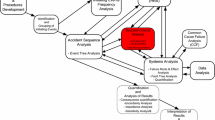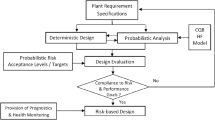Abstract
Success criteria analysis (SCA) bridges the gap between deterministic and probabilistic approaches for risk assessment of complex systems. To develop a risk model, SCA evaluates systems behaviour in response to postulated accidents using deterministic approach to provide required information for the probabilistic model. A systematic framework is proposed in this article for extracting the front line systems success criteria. In this regard, available approaches are critically reviewed and technical challenges are discussed. Application of the proposed methodology is demonstrated on a typical Westinghouse-type nuclear power plant. Steam generator tube rupture is selected as the postulated accident. The methodology is comprehensive and general; therefore, it can be implemented on the other types of plants and complex systems.













Similar content being viewed by others
References
Normal Carl Rasmussen, Reactor safety study, an assessment of accident risks in US commercial nuclear power plants, NUREG 75/014 (1975)
W. Keller, M. Modarres, A historical overview of probabilistic risk assessment development and its uses in nuclear power industry: a tribute to the late Professor Norman Carl Rasmussen. Reliab. Eng. Syst. Saf. 89, 271–285 (2005). doi:10.1016/j.ress.2004.08.022
EPRI, PRA procedures guide: a guide to the performance of probabilistic risk assessments for nuclear power plants, NUREG/CR-2300 (1983)
US NRC, Severe accident risks: an assessment for five US nuclear power plants (1990)
ASME/ANS, Standard for Level 1/large early release frequency PRA for NPP applications, Standard ASME/ANS-RA-S (2008)
ASME/ANS, Probabilistic risk assessment standard for advanced non-LWR nuclear power plants, Standard ASME/ANS RA-S-1.4-2013 (2013)
ANS/ASME, Requirements for low power and shutdown probabilistic risk assessment, Standard ANS/ASME-58.22-2014 (2014)
ASME/ANS, Severe accident progression and radiological release (Level 2) PRA standard for nuclear power plant applications for light water reactors (LWRs), ASME/ANS RA-S-1.2-2014 (2014)
M. Stamatelatos, H. Dezfuli, Probabilistic risk assessment procedures guide for NASA managers and practitioners, NASA/SP-2011-3421 (2011)
I.A. Papazoglou, Z. Nivolianitou, O. Anez et al., Probabilistic safety analysis in chemical installations. J. Loss Prev. Process Ind. 5(3), 181–191 (1992). doi:10.1016/0950-4230(92)80022-Z
R.R. Fullwood, Probabilistic Safety Assessment in Chemical and Nuclear Industries (Butterworth-Heinemann, Woburn, 2000)
J. Tixiera, G. Dusserrea, O. Salvib, D. Gaston, Review of 62 risk analysis methodologies of industrial plants. J. Loss Prev. Process Ind. 15(4), 291–303 (2002). doi:10.1016/S0950-4230(02)00008-6
G.E. Apostolakis, How useful is quantitative risk assessment? Risk Anal. 24(3), 515–520 (2004). doi:10.1111/j.0272-4332.2004.00455.x
S. Schroer, M. Modarres, An event classification schema for evaluating site risk in a multi-unit nuclear power plant probabilistic risk assessment. Reliab. Eng. Syst. Saf. 117, 40–51 (2013). doi:10.1016/j.ress.2013.03.005
M. Rausand, Risk assessment: theory, methods, and applications (Wiley, Hoboken, 2013)
S.M. Hoseyni, F. Yousefpour, A. Aghaei, K. Karimi, S.M. Hoseyni, Effects of soil-structure interaction on fragility and seismic risk; a case study of power plant containment. Loss Prev. Process Ind. 32, 276–285 (2014). doi:10.1016/j.jlp.2014.09.009
S.M. Hoseyni, M. Pourgol-Mohammad, A.A. Tehranifard, F.A. Yousefpour, A systematic framework for effective uncertainty assessment of severe accident calculations; Hybrid qualitative and quantitative methodology. Reliab. Eng. Syst. Saf. 125, 22–35 (2014). doi:10.1016/j.ress.2013.06.037
A. Prosek, M. Cepin, Success criteria time windows of operator actions using RELAP5/MOD3.3 within human reliability analysis. J. Loss Prev. Process Ind. 21, 260–267 (2008). doi:10.1016/j.jlp.2007.06.010
K. Karimi, F. Yousefpour, A. Abbaspour, M. Pourgol-Mohammad, Assessment of human error importance in PWR PSA. Rom. J. Phys. 59(7–8), 873–883 (2014)
R. Barati, S. Setayeshi, On the operator action analysis to reduce operational risk in research reactors. Process Saf. Environ. Prot. 92(6), 789–795 (2014). doi:10.1016/j.psep.2014.02.006
USNRC, Confirmatory TH analysis to support specific success criteria in the risk models, NUREG -1953 (2011)
USNRC, An approach for determining the technical adequacy of probabilistic risk assessment results for risk-informed activities, Regulatory Guide 1.200 (2009)
M. Pourgol-Mohammad, S.M. Hosseini, Comprehensive uncertainty assessment methodology for probabilistic risk assessment, Proceedings of PSA2011 Conference, Wilmington (2011)
S.M. Hoseyni, M. Pourgol-Mohammad, Model uncertainty in severe accident calculations: a structural methodology with application on LOFT LP-FP-2 experiment. J. Nucl. Tech. 193(3), 341–363 (2016). doi:10.13182/NT15-47
T.W. Kim, V.N. Dang, M.A. Zimmermann et al., Quantitative evaluation of change in core damage frequency by postulated power uprate: medium-break loss-of-coolant-accidents. Ann. Nucl. Energy 47, 69–80 (2012). doi:10.1016/j.anucene.2012.04.021
C.J. Everline, Illustration of integrating mechanistic best-estimate analysis results in Level 1 probabilistic risk assessment. Reliab. Eng. Syst. Saf. 44, 139–152 (1994). doi:10.1016/0951-8320(94)90006-X
H.F. Martz, L.L. Harem, W.H. Reed et al., Combining mechanistic best-estimate analysis and Level 1 probabilistic risk assessment. Reliab. Eng. Syst. Saf. 39, 89–108 (1993). doi:10.1016/0951-8320(93)90151-N
Y.J. Cho, T.J. Kim, H.G. Lim et al., Effect of uncertainties in best-estimate thermal hydraulic analysis on core damage frequency for PSA. Nucl. Eng. Des. 240(12), 4021–4030 (2010). doi:10.1016/j.nucengdes.2010.01.014
M. Pourgol-Mohammad, “Effect of uncertainties in best-estimate thermal hydraulic analysis on core damage frequency for PSA” Y.-J. Choa, T.-J. Kima, H.-G. Limb, G.-C. Parka. Nucl. Eng. Des. 241(9), 4060 (2011). doi:10.1016/j.nucengdes.2011.07.021
IAEA, Accident analysis for nuclear power plant, IAEA-SRS-No.023 (2002)
ASME, Standard for Level 1/large early release frequency probabilistic risk assessment for nuclear power plant applications, ASME/ANS RA-Sa-2009 (2009)
IAEA, Determining the quality of probabilistic safety assessment (PSA) for applications in nuclear power plants, IAEA TECDOC-1511 (2006)
BNPP, PSA Level-1 at Power for Bushehr Nuclear Power Plant (2003)
Author information
Authors and Affiliations
Corresponding author
Rights and permissions
About this article
Cite this article
Hoseyni, S.M., Karimi, K., Hoseyni, S.M. et al. Success criteria analysis in support of probabilistic risk assessment for nuclear power plants: application on SGTR accident. NUCL SCI TECH 28, 33 (2017). https://doi.org/10.1007/s41365-017-0193-z
Received:
Revised:
Accepted:
Published:
DOI: https://doi.org/10.1007/s41365-017-0193-z




